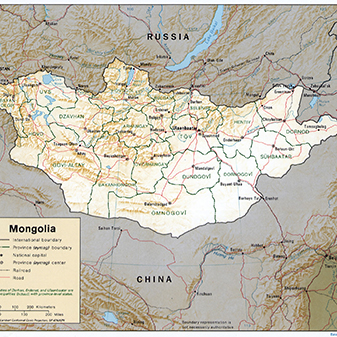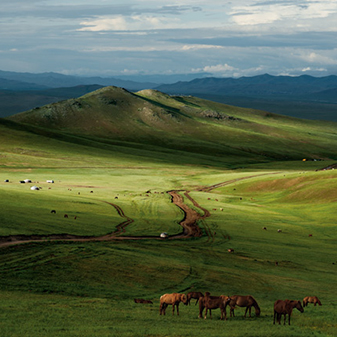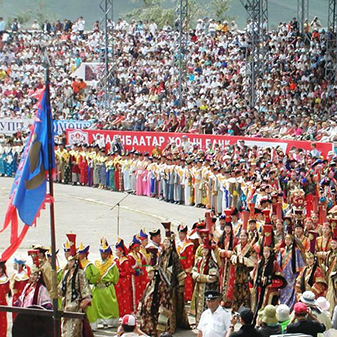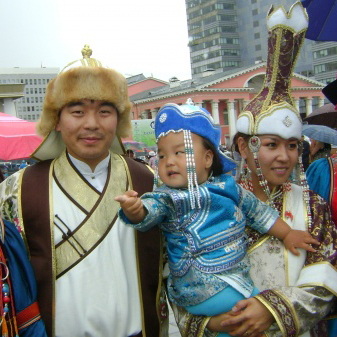CULTURE
The Mongolian way of life is nomadic and intimately connected with the ways of animals. Despite urbanization, the traditions of the steppes live on. Even in the cities, most Mongolians continue to live in a ger, a large, white felt tent that can be moved easily and has a universal layout: the door always faces south; towards the back and a little to the west is the place of honour set aside for guests; the back of the ger, the khoimor, is the place for elders and most treasured possessions; and on the back wall is the family altar, with Buddhist images, family photos and suitcases. Get a local to explain the dozens of traditional, religious and superstitious rules and customs associated with gers.

CULTURE
The Mongolian way of life is nomadic and intimately connected with the ways of animals. Despite urbanization, the traditions of the steppes live on. Even in the cities, most Mongolians continue to live in a ger, a large, white felt tent that can be moved easily and has a universal layout: the door always faces south; towards the back and a little to the west is the place of honour set aside for guests; the back of the ger, the khoimor, is the place for elders and most treasured possessions; and on the back wall is the family altar, with Buddhist images, family photos and suitcases. Get a local to explain the dozens of traditional, religious and superstitious rules and customs associated with gers.


Mongolians have always taken wholeheartedly to Tibetan Buddhism and the links between Mongolia and Tibet are old and deep. Once in a lifetime, every devout Buddhist Mongolian tries to reach the holy city of Lhasa; the Tibetans in turn have relied on various Mongolian tribes to sustain their power. In Mongolia at the time of the communist takeover in 1921, there were 110,000 lamas (monks) living in about 700 monasteries. Beginning in the 1930s, thousands of monks were arrested, sent to Siberian labor camps and never heard from again. Monasteries were closed and ransacked and all religious worship and ceremonies outlawed. Not until 1990 was freedom of religion restored. Since then, there’s been a phenomenal revival of Buddhism (and other religions). Monasteries have reopened, and even some ex-Communist Party officials have become lamas. Monasteries and temples (sum) always have Tibetan names. There’s a significant minority of Sunni Muslims in the far western regions of Mongolia, most of whom are ethnic Kazaks.
Mongolia’s paintings, music and literature are dominated by Tibetan Buddhism and nomadism. Tsam dances are performed to exorcise evil spirits and are influenced by nomadism and Shamanism. Outlawed during communism, they’re beginning to be performed again. Traditional music involves a wide range of instruments and singing styles. In Mongolian khoomi singing, carefully trained male voices produce harmonic overtones from deep in the throat, releasing several notes at once. Traditional music and dance performances aren’t complete without a touch of contortionism, an ancient Mongolian tradition.
Mongolians have always taken wholeheartedly to Tibetan Buddhism and the links between Mongolia and Tibet are old and deep. Once in a lifetime, every devout Buddhist Mongolian tries to reach the holy city of Lhasa; the Tibetans in turn have relied on various Mongolian tribes to sustain their power. In Mongolia at the time of the communist takeover in 1921, there were 110,000 lamas (monks) living in about 700 monasteries. Beginning in the 1930s, thousands of monks were arrested, sent to Siberian labor camps and never heard from again. Monasteries were closed and ransacked and all religious worship and ceremonies outlawed. Not until 1990 was freedom of religion restored. Since then, there’s been a phenomenal revival of Buddhism (and other religions). Monasteries have reopened, and even some ex-Communist Party officials have become lamas. Monasteries and temples (sum) always have Tibetan names. There’s a significant minority of Sunni Muslims in the far western regions of Mongolia, most of whom are ethnic Kazaks.
Mongolia’s paintings, music and literature are dominated by Tibetan Buddhism and nomadism. Tsam dances are performed to exorcise evil spirits and are influenced by nomadism and Shamanism. Outlawed during communism, they’re beginning to be performed again. Traditional music involves a wide range of instruments and singing styles. In Mongolian khoomi singing, carefully trained male voices produce harmonic overtones from deep in the throat, releasing several notes at once. Traditional music and dance performances aren’t complete without a touch of contortionism, an ancient Mongolian tradition.

Mongolian, the official language, is a member of the Ural-Altaic family of languages, which includes Finnish, Turkish, Kazak, Uzbek and Korean. Since 1944, the Russian Cyrillic alphabet has been used to write Mongolian. The country has produced a huge literature, almost none of which is known to speakers of European languages. Only recently have scholars translated the most important text of all – Mongolun Nigucha Tobchiyan (The Secret History of the Mongols) – which celebrates Mongolia’s days of greatness.
An old Mongolian saying goes something like: “Breakfast, keep for yourself; lunch, share with your friends; dinner, give to your enemies”. The biggest and most important meals for Mongolians are breakfast and lunch, which will usually consist of boiled mutton with lots of fat and flour and maybe some dairy products or rice. The Kazaks in western Mongolia add variety to their diet with horse meat. The Mongolians are big tea drinkers and the classic drink is suutei tsai (salty tea with milk). Men who refuse to drink arkhi (vodka) are considered wimps, while herders make their own unique home brew airag, which is fermented horse’s milk with an alcoholic content of about 3%. Many Mongolians distill it further to produce shimiin arkhi, which boosts the alcohol content to around 12%.

Mongolian, the official language, is a member of the Ural-Altaic family of languages, which includes Finnish, Turkish, Kazak, Uzbek and Korean. Since 1944, the Russian Cyrillic alphabet has been used to write Mongolian. The country has produced a huge literature, almost none of which is known to speakers of European languages. Only recently have scholars translated the most important text of all – Mongolun Nigucha Tobchiyan (The Secret History of the Mongols) – which celebrates Mongolia’s days of greatness.
An old Mongolian saying goes something like: “Breakfast, keep for yourself; lunch, share with your friends; dinner, give to your enemies”. The biggest and most important meals for Mongolians are breakfast and lunch, which will usually consist of boiled mutton with lots of fat and flour and maybe some dairy products or rice. The Kazaks in western Mongolia add variety to their diet with horse meat. The Mongolians are big tea drinkers and the classic drink is suutei tsai (salty tea with milk). Men who refuse to drink arkhi (vodka) are considered wimps, while herders make their own unique home brew airag, which is fermented horse’s milk with an alcoholic content of about 3%. Many Mongolians distill it further to produce shimiin arkhi, which boosts the alcohol content to around 12%.







